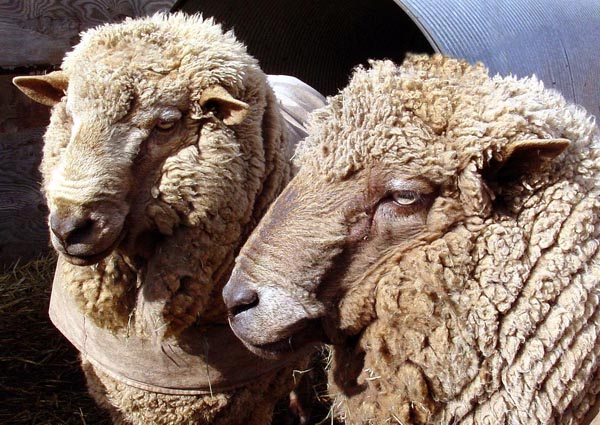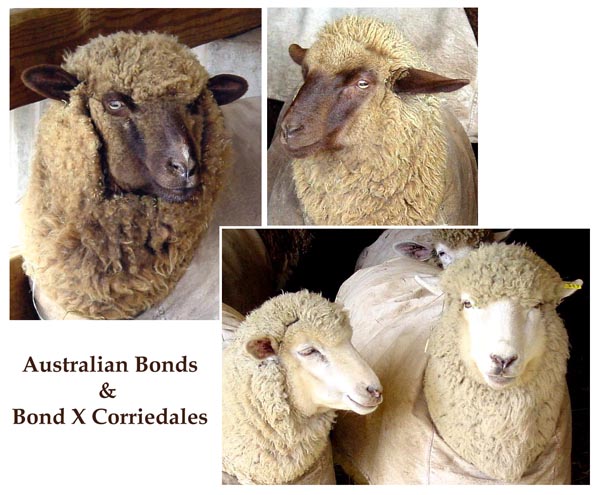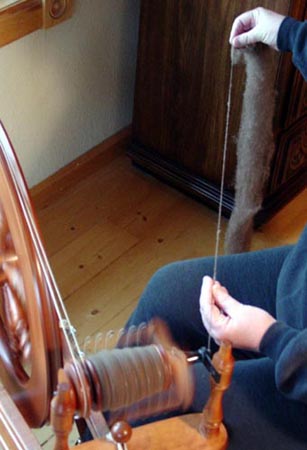Importing Australian Bond Sheep to the USA
By Joanna Gleason
(as this article appeared in 2004 on the web site: http://www.handspinners.com/archives/fall2004/joanna.html)
We have kept a flock of Corriedales since 1986 and have ever tried to breed true to the original breed character. As the years passed it became impossible to find additional breeding stock that had not been bred for size while disregarding the fleece qualities. In a many year quest to improve our breeding stock and fleeces, it seemed after much research that the thing to do was to import the Australian Bond breed of sheep.
The Bond breed is close to the Corriedale breeding in that it too was a Merino X Lincoln, but with more of an emphasis on a finer, longer staple. From the OSU Encyclopedia of Sheep Breeds: "Bonds evolved in Australia in 1909 as a dual-purpose breed, using Peppin Merinos and imported Lincoln rams. The Australian Bond Sheep Breeders' Association has existed since 1984. It now has 30 registered studs that sell more than 3,000 rams annually. Wool selection for Bond sheep is for big, bulky, long stapled bright 22-28 micron fibers. Bonds are renowned for long, lean, fast growing lambs. Their robust constitution means they are capable of coping with extreme climatic conditions. Bond sheep are mainly found in the southeast portion of Australia. Being a new breed, numbers available for export are limited."
Importing the Bonds was an ongoing test of patience and determination to overcome all of the obstacles to get the two breeding rams and two breeding ewes from New South Wales to Lyons, Colorado. The four sheep are all moorit Bonds from the flock of Mr. Cyril Lieschke of Cora Lynn, near Henty, NSW. Cyril's farm has long been known for the quality breeding of coloured Merinos, Bonds and Corriedales. At one time, his coloured ewe flock was the largest known in the world. His flock seemed the best possible source for the moorit Bonds, as they are currently unavailable anywhere in the USA. The moorit (brown fleece) genetics are also somewhat rare, particularly in the Corriedale breed. We could have gone to Merino genetics but those genetics are also somewhat altered in the USA from their original character.
While the specifics of the quarantine procedure may not be of interest to the general reader, it is of greatest importance to the shepherd. The shepherd in Australia who may wish to export breeding stock into the USA must meet all of the below requirements. Some of these requirements take years to achieve, so planning ahead and excellent animal care at all times are essential.
The vigilance and care expressed by both AQIS and the USA counterpart APHIS in completing all of the below testing is quite reassuring to the shepherd. The testing was done twice during the 60-day quarantine in Australia, then repeated in full again while the sheep were in the 30-day quarantine in Los Angeles. If at any time during the 90 days of quarantine any of the sheep had been found to have any of the listed diseases, all four of the sheep would have been destroyed.
Meeting the required 90 days of quarantine was the most expensive part of the whole importation total cost (more than the flight to the USA). It was during this time that the greatest financial risk is taken, as one is required to pay these costs whether or not the animals survive.
It is important to know that if one wanted to import semen straws (as opposed to the live breeding stock) the 60 days of quarantine would be observed in Australia before the semen is collected. The stud ram would be destroyed, rather than returned to the flock. Adding together the expense of the quarantine, collection, and cost of the ram, importing semen can also be quite expensive. Then there are the additional expenses of its storage before use and inseminating the semen over a period of years. On the whole, we thought bringing in the live stud animals was preferable. In fact, the cost per animal decreased by bringing in four instead of two sheep.
Australian Certification and 60 Day Quarantine for Export:
1) Australia is free of foot-and-mouth disease (FMD), rinderpest, surra, scrapie, contagious pleuropneumonia, sheep pox, and goat pox.
2) Animals for export were born in Australia and have been in Australia their entire lives, and are not the first generation progeny of animals, embryos, or semen that have been imported into Australia from FMD counties and these animals or their progenies have been released from any type AQIS import quarantine restrictions for at least 60 days.
3) The animals have been south of the Culicoides brevitarsis Line no less than 60 days.
4) Before entry of the animals into the pre-embarkation quarantine facility, all animals were individually identified using a metal eartag, tattoo or brand.
5) There have been no reports of Johne's disease among animals offered for export during the previous 5 years.
6) The flock of origin of the animals intended for export have been free, of clinical or serological evidence for the 12 months preceding qualifying for export, of any evidence of bluetongue, epizootic haemorrhagic disease, akabane, anio, Brucella ovis, tuberculosis and visna/maedi.
7) The flock of origin of animals intended for export into the United States have been inspected by a veterinarian designated by the AQIS and they have been found to be free of any evidence of infectious and communicable diseases, or exposure thereto, at the time the animals are selected for export.
8) Vibrio fetus has not been diagnosed by clinical diagnosis or laboratory means.
USA 30 day quarantine and testing: Brucellosis, tuberculosis, BT (Elisa), EHD (Agid), AINO (VN), and AKABAN, B Ovis

Nimbus and James: the original stud rams
 Bond ewes and Bond X Corriedale ewes
Bond ewes and Bond X Corriedale ewes
When we drove out to LA to get the sheep, we found that American quarantine facilities really don't compare to what is available in Australia. While in quarantine in Australia, the owner of the facility corresponded with us by email quite often and kept us informed of the testing and care of the sheep. They were very careful to put the sheep on a diet that could be found here in the USA, so that when transported to LA, we could arrange to have that diet continued. There are only three facilities in the entire USA, and they are for use by horses. We found the sheep had been housed in a concrete barn with no windows, and had been bedded on sawdust. The quite wonderful (and expensive) four-compartment wooden crate they had been kept in during the flight had to be burned along with all of the bedding from the thirty days of quarantine. Finally on May 4th, 2000 at precisely 9:00 am we were able to load the sheep and bring them home to Colorado.
We are extremely pleased with the Bonds and the Corriedale crosses. The fleeces produced are dense; heavy, long stapled, and have a very soft handle. The character of the sheep themselves is quite appealing and pleasing; an important inducement to spending time with them while caring for them year round and lambing. On the whole, importing the Bonds has been a very good experience and has greatly improved our flock genetics.

Bond and Bond X Corriedale Fleece Locks
When hand spinning the Bond wool, a long draw is my favorite method. The fleece is washed and carded, then spun and plied. My yarns aren't typically spun very fine, although the wool may be. The yarns shown in the photo are about 10 WPI. The moorit browns have a colour softening effect on dyed wools.
 10 WPI 2-ply Yarns
10 WPI 2-ply Yarns
|
 Long draw drafting on an Ashford Wheel
Long draw drafting on an Ashford Wheel
|
|
Here are some additional comments from another hand spinner (Meg Caulmare)
She also washes and cards, then spins, for the most part using a long draw.
After carding she splits the batt into quarters from top to bottom, cards again, splits again into quarters, and then does a bit of pre-drafting. Meg spins on the highest ration of her Ashford, 17:1. The plied yarn gets wound into a skein, steamed, and then several skeins are washed later.
When she spins from the lock, she holds a lock by the cut end, and "plucks" at the tips, (that is plenty to make the lock *pop* wide open, "like a ripe cattail"), then spins from the tips, with a long draw, drafting back to the hip and winding on, just as above. The yarn is "bouncier" when spun from the lock, and makes maximum use of the fleece's own elasticity.
The Bond singles are 40 WPI. The freshly plied yarn is 18 WPI. The steamed, washed skeins are 17 WPI. When wrapping she uses moderate compression. The two plies spun from the locks, are also 18 WPI and there's no question that those strands are even plumper than the carded preparation and the skeins themselves have even more bounce.
The Bond breed has been especially selected for softness of handle and elasticity. We find the fleece character to be exceptional in these qualities. The bold crimp is unusual for the finer fiber diameter of the wool. The wool is also good as a "felting wool".
All of the rams and ewes have proved to be excellent breeding stock. Their fleece character and colour have easily been bred into our Corriedale flock. We now have a total of 14 pure moorit Bond rams and ewes. We have many 1/2 Bond X 1/2 Corriedales, 3/4 Bonds, and look forward next spring to our first 7/8ths Bonds. At 3/4's blood, the Bond crosses already have most of the Bond character, frame size, and all of the fleece character.
For more photos of Bond sheep, hand spun yarns, and felted projects, please visit our web site at http://www.gfwsheep.com
[an error occurred while processing this directive]

 Bond ewes and Bond X Corriedale ewes
Bond ewes and Bond X Corriedale ewes

 10 WPI 2-ply Yarns
10 WPI 2-ply Yarns
 Long draw drafting on an Ashford Wheel
Long draw drafting on an Ashford Wheel